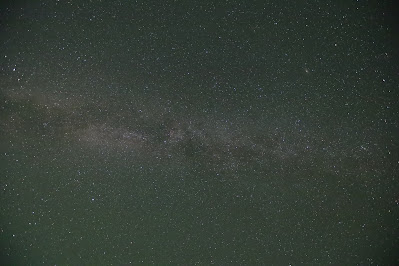Racetrack Playa is a place of natural intrigue. Situated in the heart of Death Valley, this dry, cracked lake bed is renowned for its "sailing stones" — large rocks that mysteriously move across the playa, leaving long tracks behind them. For decades, these stones puzzled scientists and visitors alike, as no one could quite figure out how these hefty rocks glided across the desert floor. It wasn’t until recently that a rare combination of ice, water, and wind was identified as the culprit behind their movement.
 |
| The Milky Way Over the Sailing Stones of Death Valley, California |
Panorama 27 photos, Canon EOS Ra, EF16-35mm f/2.8L II USM Lens, f/2.8, ISO-25600, 20 seconds each photo.
When night falls at Racetrack Playa, another marvel unfolds overhead. With its location in one of the darkest national parks in the U.S., the sky above Death Valley becomes a portal to the universe. The absence of light pollution allows for one of the most pristine views of the Milky Way, an ocean of stars arching across the sky, giving photographers an ideal canvas for astrophotography.
Standing in the silence of Racetrack Playa under the brilliant Milky Way, one feels both humbled and uplifted. The ancient stones, moved over time by forces unseen, seem like they are part of a larger cosmic ballet, just as the stars above trace their eternal paths through space. In that quiet desert night, there is a profound sense of stillness, yet the sky and stones speak of movement across millennia.
















